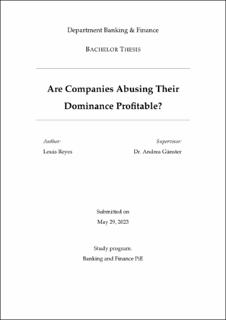Please use this identifier to cite or link to this item:
https://doi.org/10.21256/zhaw-30199Full metadata record
| DC Field | Value | Language |
|---|---|---|
| dc.contributor.advisor | Günster, Andrea Maria | - |
| dc.contributor.author | Reyes, Louis | - |
| dc.date.accessioned | 2024-03-15T12:59:52Z | - |
| dc.date.available | 2024-03-15T12:59:52Z | - |
| dc.date.issued | 2023 | - |
| dc.identifier.uri | https://digitalcollection.zhaw.ch/handle/11475/30199 | - |
| dc.description.abstract | In 2024, the European commission is rolling out one of the most potent new policies when it comes to antitrust regulation: The Digital Market Act (DMA). Indeed, this is the consequence resulting from a global trend, where companies have enjoyed increased market dominance and market power in the recent years. This can also be observed when analysing the European Commission (EC) cases, as the number of investigations and fines has grown substantially. Our analysis focuses on researching this trend and its potential effects on companies which have been investigated and their stocks returns. After setting the scene for a brief understanding of the European Antitrust system, and an overview of the impact of collusion on stock markets, we look in detail for all the case decisions issued by the European Commission from 1980-2022, which infringed solely article 102 of The Treaty on the Functioning of the EU (TFEU). After some adjustments, we analyse 32 EC case decisions stemming from 26 companies, present in 10 sectors and spread out across 10 countries. We provide an extensive summary of the cases, companies and the reasoning behind cases which needed to be excluded. The cases are defined either as commitment decisions, where companies must commit in written to changing their dominant positions, or infringement decisions which usually entail a fine to punish the anti-competitive behaviour of the company. We create a panel-like data structure, defined by company and by trading day, to put in relation the stock returns with their respective main index returns and key explanatory variables from the cases retrieved. We run three different models, all based on the assumptions of the Capital Asset Pricing Model (CAPM), including time and company fixed effects, to better understand the relation between abuse of dominance and stock returns. Interestingly, we observe three key results. Firstly, we find companies which received an infringement decision, performed significantly better (nearly 5 bps positive) before the period of abuse started. Secondly, companies which needed to commit to reducing or changing their dominant position exhibit no significant positive nor negative returns. We find these results to be in line with previous studies describing the lack of incentive to become more efficient as soon as one company has reached a position of power. Lastly, we observe that commitment decisions have a significantly negative return (roughly 4 bps negative) compared to other periods when the companies committed to change. This finding is by far the most surprising as it goes against the Market Efficiency Theory and could be interpreted as a potential short strategy for investors. Policy makers and researchers in future studies could replicate our study once the Digital Market Act has been implemented. Furthermore, investors could also build on our results to create new trading strategies. | de_CH |
| dc.format.extent | 47 | de_CH |
| dc.language.iso | en | de_CH |
| dc.publisher | ZHAW Zürcher Hochschule für Angewandte Wissenschaften | de_CH |
| dc.rights | https://creativecommons.org/licenses/by-nc-nd/4.0/ | de_CH |
| dc.subject | Abuse of dominance | de_CH |
| dc.subject | Antitrust | de_CH |
| dc.subject | Competition | de_CH |
| dc.subject.ddc | 338: Produktion | de_CH |
| dc.title | Are companies abusing their dominance profitable? | de_CH |
| dc.type | Thesis: Bachelor | de_CH |
| dcterms.type | Text | de_CH |
| zhaw.departement | School of Management and Law | de_CH |
| zhaw.publisher.place | Winterthur | de_CH |
| dc.identifier.doi | 10.21256/zhaw-30199 | - |
| zhaw.originated.zhaw | Yes | de_CH |
| Appears in collections: | BSc Betriebsökonomie | |
Files in This Item:
| File | Description | Size | Format | |
|---|---|---|---|---|
| 2023_Reyes_Louis_BA_BO.pdf | 483.79 kB | Adobe PDF |  View/Open |
Show simple item record
Reyes, L. (2023). Are companies abusing their dominance profitable? [Bachelor’s thesis, ZHAW Zürcher Hochschule für Angewandte Wissenschaften]. https://doi.org/10.21256/zhaw-30199
Reyes, L. (2023) Are companies abusing their dominance profitable? Bachelor’s thesis. ZHAW Zürcher Hochschule für Angewandte Wissenschaften. Available at: https://doi.org/10.21256/zhaw-30199.
L. Reyes, “Are companies abusing their dominance profitable?,” Bachelor’s thesis, ZHAW Zürcher Hochschule für Angewandte Wissenschaften, Winterthur, 2023. doi: 10.21256/zhaw-30199.
REYES, Louis, 2023. Are companies abusing their dominance profitable? Bachelor’s thesis. Winterthur: ZHAW Zürcher Hochschule für Angewandte Wissenschaften
Reyes, Louis. 2023. “Are Companies Abusing Their Dominance Profitable?” Bachelor’s thesis, Winterthur: ZHAW Zürcher Hochschule für Angewandte Wissenschaften. https://doi.org/10.21256/zhaw-30199.
Reyes, Louis. Are Companies Abusing Their Dominance Profitable? ZHAW Zürcher Hochschule für Angewandte Wissenschaften, 2023, https://doi.org/10.21256/zhaw-30199.
Items in DSpace are protected by copyright, with all rights reserved, unless otherwise indicated.